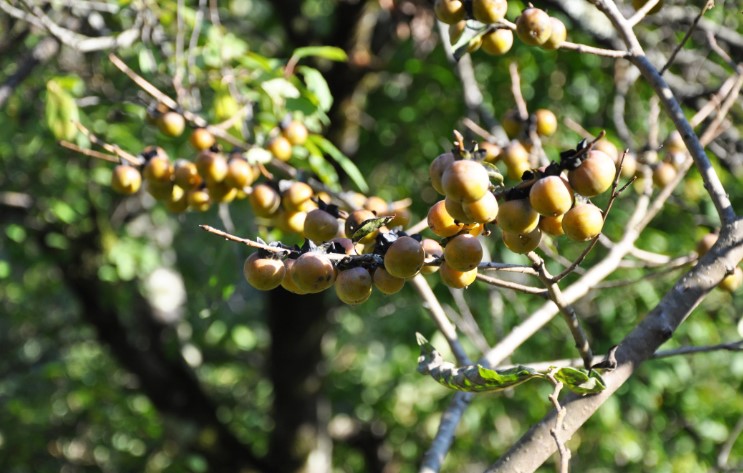Origin and history: Date plum (Diospyros lotus) is among the lesser-known members of the persimmon genus (in the ebony family, Ebenaceae). But they are native to much of temperate Asia, especially China, along with Japan and the Himalayas. A common fruit tree, rootstock, and other useful products are produced from it in mixed mountain forests.
Description: A small or medium-sized tree that reaches a height of 6–12 m (20–40 ft) in cultivation but can reach a height of double that in the wild, with an average spread of 6 m (20 ft). There is a rounded crown on this tree. The bark of older trees becomes furrowed and cracked. On the stems, the leaves are oval, dark green, glossy, leathery, tough, and alternate.
Male flowers are 5mm in diameter, females 8–10 mm in diameter, greenish-yellow tinged red, appearing from the leaf axils, mostly on one-year-old shoots. Female flowers are produced singly, males in clusters of 1–3 on downy stalks. Unlike other persimmon species, this species is dioecious, so male and female flowers appear on separate plants. In Britain, flowering takes place in July, and insects, including bees, pollinate the flowers.
On female plants, fertilized fruits appear; these are round (cherry tomato shape and size), 15-20mm (0.6–0.8ins) in diameter, green when immature, and ripening to yellow or reddish-purple with a blue bloom. Aromatically, they are similar to blackcurrants. Despite its four lobes, the calyx remains attached to the fruit’s base. Until they ripen, or after a frost, persimmon fruits are high in tannins and very astringent; they are then sweet and flavorful. After the leaves fall in autumn, the fruits continue to hang on the tree and contain 0–8 small, flat, black seeds.

Uses: Cool climates, such as Britain, allow the fruits to develop freely. In most cases, they have to be bletted (picked and stored in a cool place) or frozen before they become edible, unless it is a particularly hot summer (when they may ripen in October). As they ripen, they become sweet and floury with a date-like texture, rich and delicious. It is usually possible to pick the fruits after the leaves fall in November since they remain on the trees after the leaves fall.
If the fruits are dried, they lose their astringency; if they are allowed to shrivel, they have a date-like texture. Asia has been a breeding ground for superior cultivars, where some breeding work has been conducted. Protein content in ripe fruits is approximately 1.9%, fat content is 0.2%, and carbohydrate content is 47.7%. Other medicinal properties of the fruit include its ability to reduce fevers and act as a secretogen.
It is widely used, especially in Asia, Europe, and North America, as a rootstock for cultivars of Oriental persimmons (Diospyros kaki). Its extra-cold hardiness affects the scion cultivar when it is grafted, since date plums are more cold-hardy than Oriental persimmons. Hence, in cooler Asian regions, D. kaki scions are grafted high on D. lotus rootstocks.
Unripe date plums are also grown commercially for their tannins, which are extracted from their unripe fruit. The tannins in these fruits (and those in unripe fallen D. kaki fruits) are widely used to deproteinize sake (rice wine). Late autumn and early winter are good times for pigs to feed on falling fruit. There are no worms in the wood, and it is durable, pliable, and resistant to rotting. Construction, joinery, and other uses are possible with it. Forage is provided by the flowers for the bees.
Plantation: It does not tolerate partial shade but needs a warm position in full sun to fruit properly. Ideally, it likes a deep, fertile, moist, but well-drained loamy soil that is well-drained and protected from the wind. It is possible for young plants to suffer from freezing damage.
The growth rate is slow to moderate—about 3m (10ft) in 10 years. It is advisable to transplant container-grown plants, as taproots are very susceptible to damage from transplanting. Trees can also be trained against a wall as a fan or espalier, or in the open as bush trees.
Hence, propagation occurs by seed or by grafting onto seedlings of D. lotus rootstock. There are approximately 8,000 seeds per kg (3,600 per lb). Make sure seeds need a short period (about four weeks) of cold stratification before they germinate. Hence, sow the seeds in warm conditions, and germination will occur within a few weeks. The first-year growth rate is 20–30 cm (8–12 inches).
Pests and diseases: There are no serious pests or diseases in the temperate zones.
Related species: persimmon (Diospyros kaki) and American persimmon (D. virginiana).
